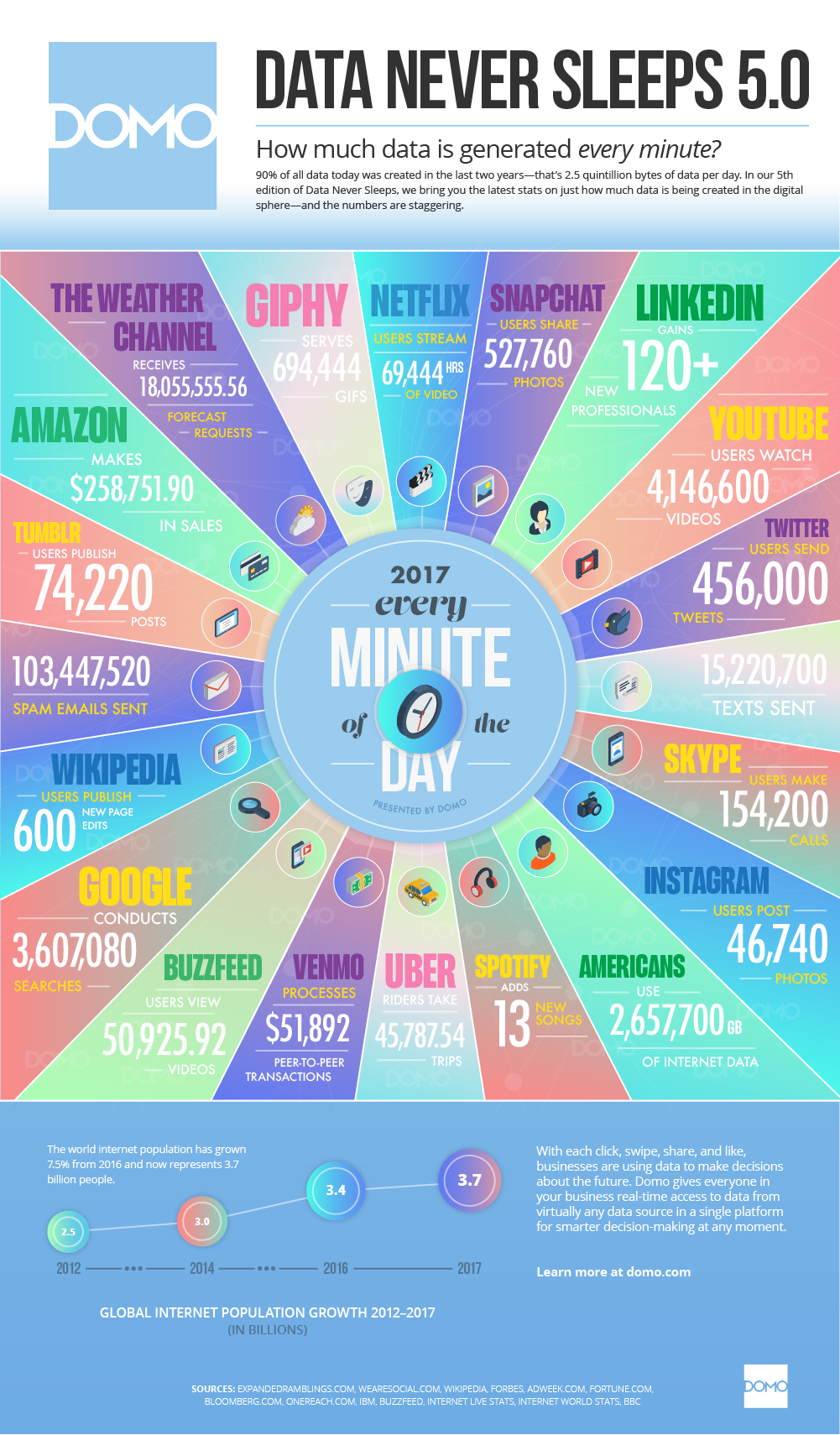Billions of people share every second of their lives on every platform under the sun, broadcasting infinite amounts of content to the world, but only consuming a fraction.
Welcome to the era of information overload and shorter attention spans.
The following actions happened every minute of the day in 2017 (full infographic below):
- 46K+ photos were posted on Instagram.
- 3.6M+ searches were conducted on Google.
- 4.1M+ videos were watched on YouTube.
- 69K+ hours of video were streamed on Netflix.
- 694K+ GIFs were served by Giphy.

Who Are the Victims?
Among the many groups affected by this growing trend, companies using content marketing to grow their online presence with very small budgets are hit the hardest.
Struggling to cut through the noise with your corporate blog will force you to spend more money on advertising to reach your target audience. Therefore, businesses that rely on online channels need to step up their game to compete against the masses.
There are many ways to improve your content marketing strategy, assuming that your company has a documented strategy to begin with, and one key element is the headline.
Headlines serve as the “gate” that separates your content from your audience. If they don’t choose to open the gate, they will never see your content, so you better build a noteworthy gate.
Headlines serve as the “gate” that separates your content from your audience.
We’ve put together 8 simple tips to write click-worthy headlines to spruce up your content marketing efforts and win the corporate blog game.
1. Pose a Question
Headlines posed as a question pique reader’s interest and elicit higher responses than those composed as a statement. Use words that create mystery (like did you know?) and remember to deliver what is promised for post-click engagement.
Example: Why Small Businesses Should Be Thankful for Amazon
2. Use Numbered Lists
People tend to be lazy and expect to receive valuable bite-size information. Enter listicles, content presented wholly or partly in the form of a list, like the viral posts popularized by BuzzFeed. Including a number in the headline helps set the expectation of how much information the reader will get.
Example: 99 New Ideas to Inspire You to Start a Business
3. Inflict Fear
Using scare tactics in the headline will activate a reader’s natural fears and entice them to read beyond the headline. Your goal is to convince them that your content is going to reveal information they don’t already know.
Example: New Tax Plan Won’t Help Small Businesses After Hurricanes and Other Disasters
4. Name-Drop
If your content features a famous person or notable influencer, you will always want to include their name in the headline, since this will create buzz around your story. Don’t forget to always spell-check the person’s name.
Example: Elon Musk Is Now Linked to the Mystery of Who Invented Bitcoin
5. Call Out The Audience
If a campaign is targeted to a specific group or audience (like small business owners), make sure to mention them in the headline, because you want them to know that your content was crafted for them specifically.
Example: Why Small Business Owners Are Turning to Crowdfunding to Save Their Companies
6. Aim for 60 Characters
Headlines should contain an average length of 60 characters and provide the audience with enough information to know what the content will be about. Length plays a bigger role with SEO – sticking to the 60-character rule makes content more searchable.
Example: 8 Tips to Write Click-Worthy Headlines for Content Marketing
Headlines should contain an average length of 60 characters and provide the audience with enough information to know what the content will be about.
7. Focus on the First 20 Characters
In addition to being concise, you also need to be as deliberate as possible, because a headline’s first 20 characters are the most important to catch the reader’s attention. This is due to the increasing information overload paired with the decreasing human attention span.
Example: Jeff Bezos Won 2017 and Set Amazon Up to Dominate the Next Decade
8. Format and Punctuation
A helpful technique when promoting formats other than editorial content, such as video or infographics, is to include the media type in the headline. This could be added at the beginning of the headline before a colon (:) or at the end between brackets.
Colons are also useful to separate a capture phrase from the rest of the headline – and question marks (?) are acceptable for question-based headlines (though not mandatory). However, you would want to avoid exclamation marks (!) and periods (.) at all costs.
Example: Infographic: Why Influencer Marketing Is Trending And Worth Trying?
Conclusion
Headlines are the one thing stopping your audience from reaching your content, but they are totally under your control, so try to get crafty when writing them for your blog posts.
You know have 8 easy-to-follow tips to write click-worthy headlines that will help amplify your content on your home page, social media, newsletter, etc.
Here are a few final suggestions:
- Creating 3-5 headlines for each piece and running them by someone else is helpful to let them choose the best option.
- Conducting A/B tests (aka split tests) to evaluate the efficiency of different headlines for the same piece of content could help optimize your writing process.
- Take advantage of free headline generators like Sumo or Title Generator to get a bunch of variations without much effort.


One Reply
Comments are closed.